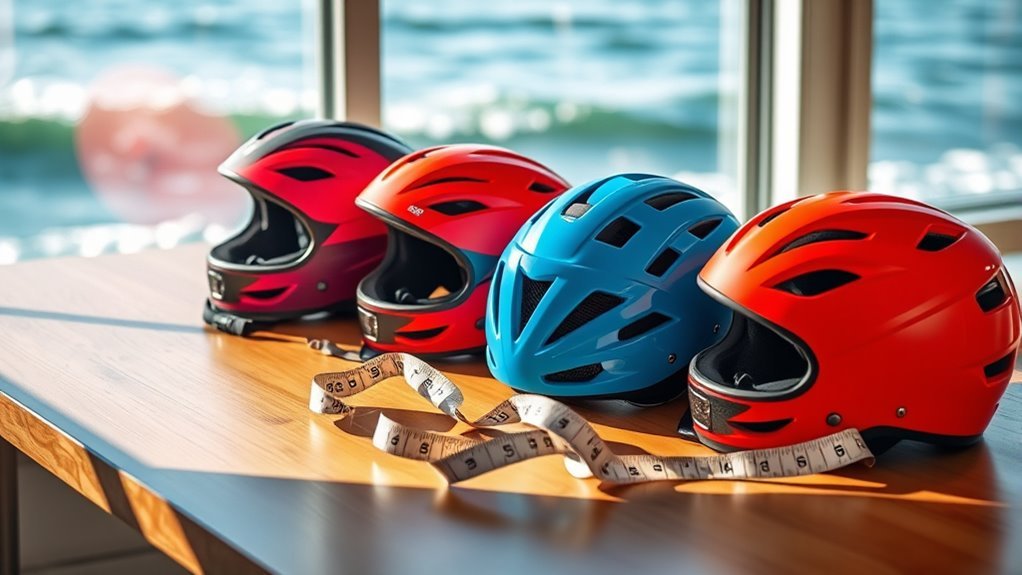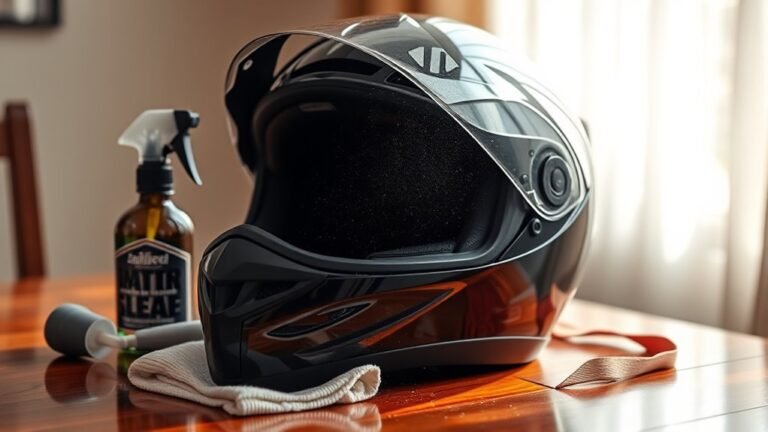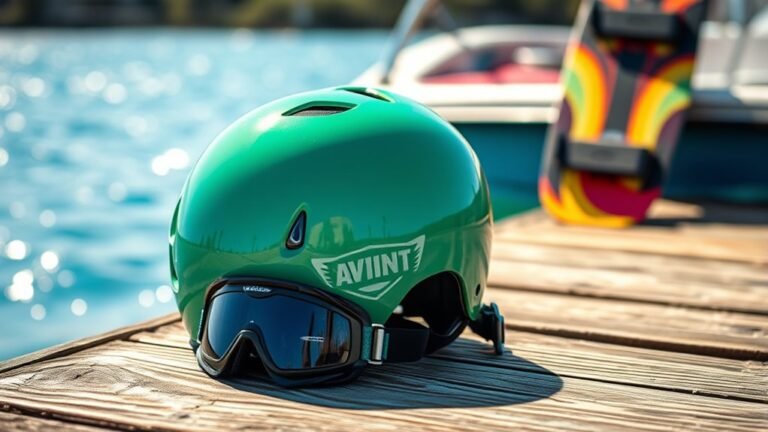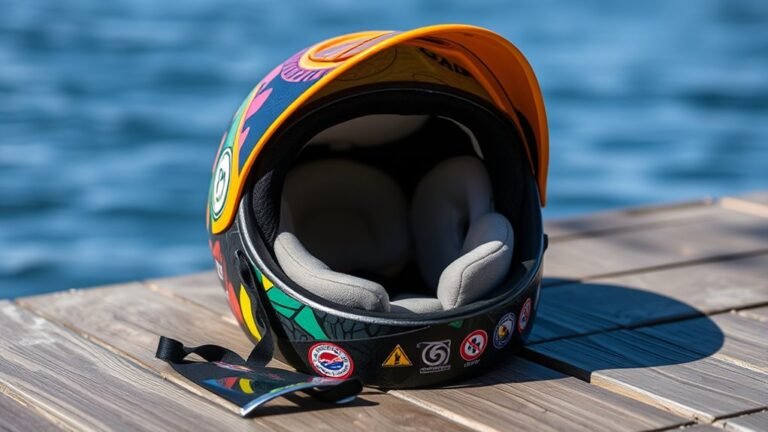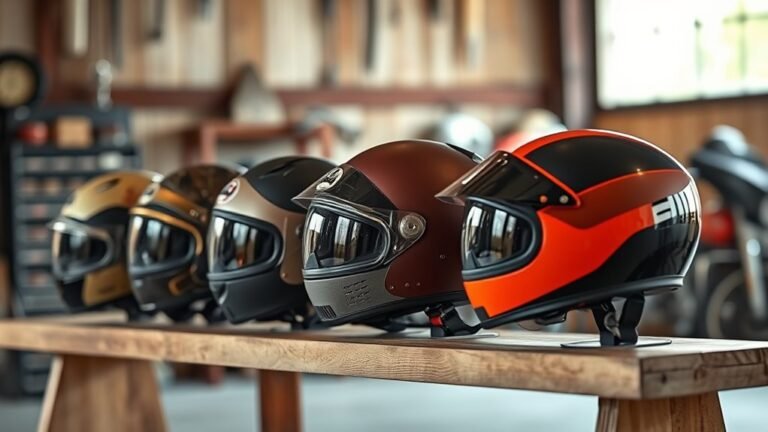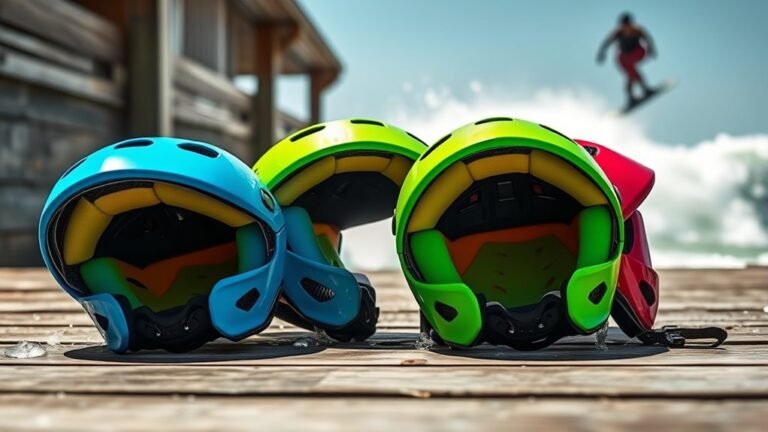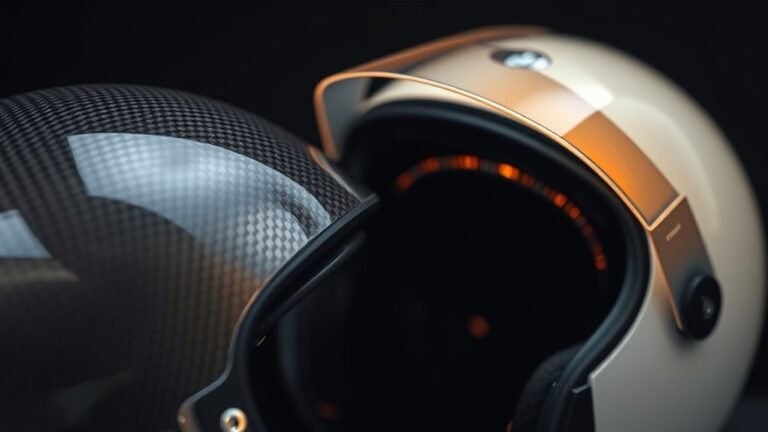Choosing the Right Size for Water Sports Helmets
Choosing the right size for water sports helmets is essential for safety and comfort. Measure your head circumference just above your ears with a flexible tape, confirming it’s snug but not tight. Try on different shapes to find the best fit for your head profile, whether it’s round or oval. Don’t overlook adjustable features for enhanced comfort, and avoid common sizing mistakes. Learn how proper maintenance can further guarantee your helmet keeps you protected on the water.
Understanding Helmet Sizing Standards
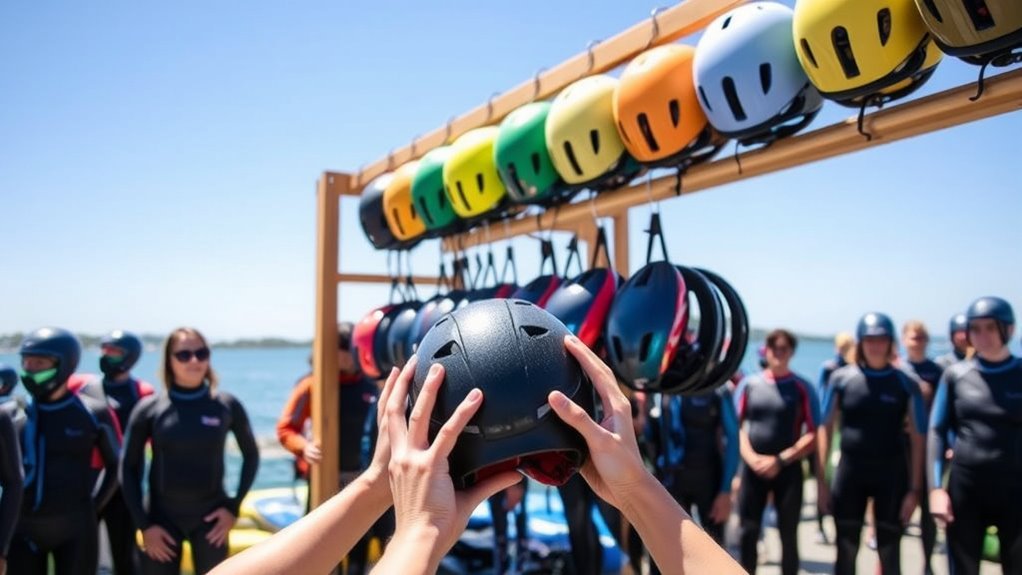
When you’re choosing a water sports helmet, understanding sizing standards is vital for your safety and comfort. Helmet sizing systems can vary greatly across brands and types, making it important to familiarize yourself with international standards. These standards help guarantee a consistent fit and performance, allowing you to enjoy your water adventures without worry. The most common sizing systems include small, medium, large, and extra-large, but some manufacturers may offer specific measurements in centimeters or inches. Always check the sizing chart provided by the manufacturer to make sure you select the right helmet for your head shape and size. A proper fit not only enhances comfort but also maximizes protection, ensuring you can fully embrace the freedom of your chosen water sport.
Measuring Your Head Correctly
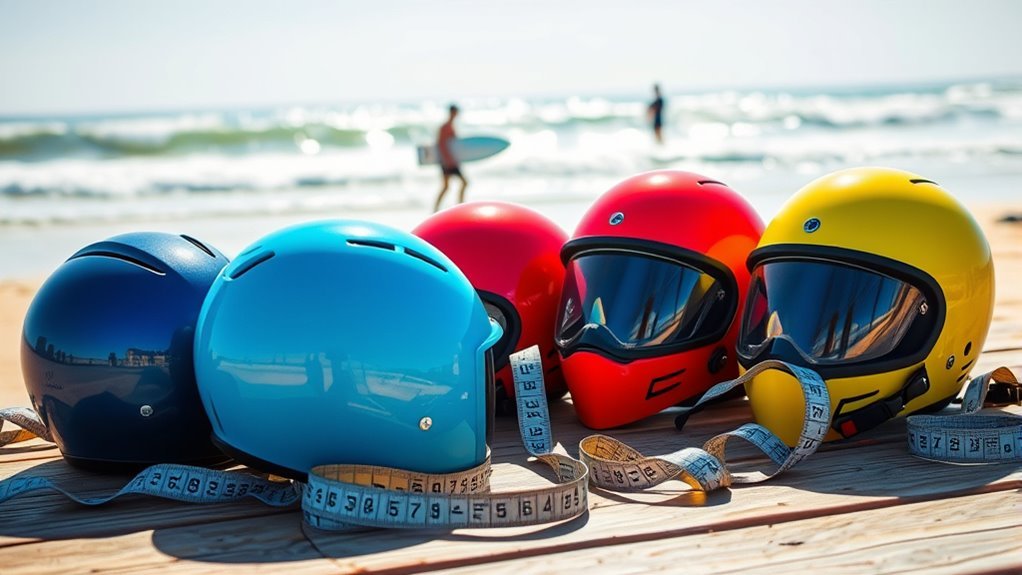
To guarantee you choose the right helmet size, you’ll need some basic tools like a flexible measuring tape and a notepad. Start by measuring the circumference of your head just above your ears, as this is essential for an accurate fit. Using proper head measurement techniques will help you select a helmet that offers both comfort and safety.
Tools Needed for Measurement
Before you start measuring your head for a water sports helmet, it’s essential to have the right tools on hand to guarantee accuracy. To determine your head circumference, you’ll need a flexible measuring tape, which is ideal for wrapping around your head comfortably. If you don’t have one, a piece of string can also work—just measure it against a ruler afterward. Make sure your measurement tools are free from any obstructions; a straightforward approach helps maintain precision. It’s best to have a mirror handy, so you can position the tape correctly. With these measurement tools ready, you’ll be set to get accurate measurements for a helmet that fits well, providing the freedom and safety you need on the water.
Head Measurement Techniques
With your measurement tools ready, it’s time to measure your head correctly for a water sports helmet. Start by wrapping a flexible measuring tape around the widest part of your head, typically just above your eyebrows and ears. Confirm the tape is snug but not tight, and take note of the measurement. It’s vital to take into account your head shape, as this can affect helmet fit. Some people have rounder heads, while others might have more oval shapes. If you can, repeat the measurement a couple of times to verify accuracy. Using these measurement techniques will help you find a helmet that offers both comfort and protection, allowing you to enjoy your water sports adventures with confidence.
Different Helmet Shapes and Their Fit
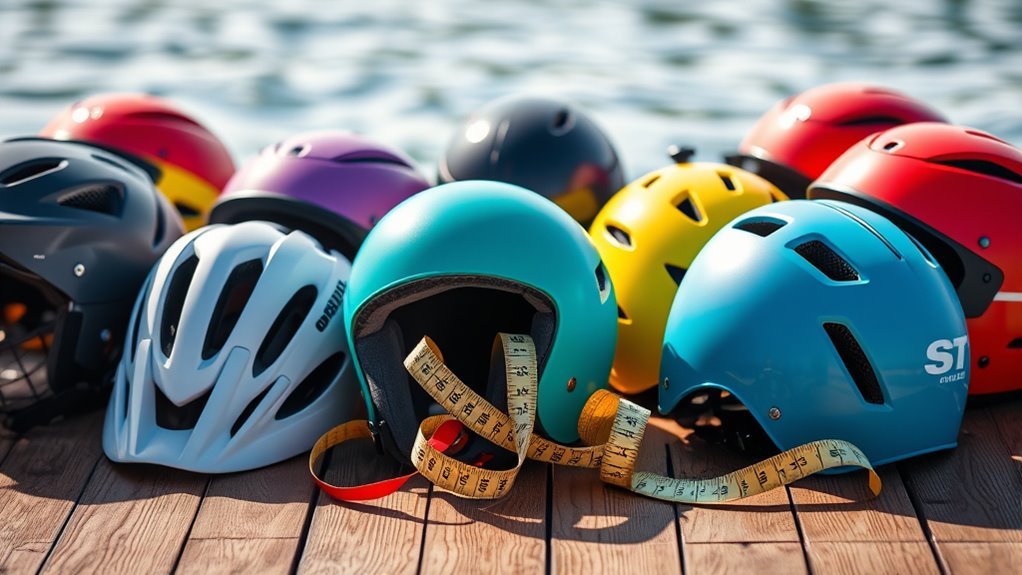
Choosing the right helmet shape is vital for comfort and safety while engaging in water sports. Different helmet shapes cater to various head profiles, which means you’ll find fit variations that can greatly affect your experience. For instance, a round shape might suit those with a more circular head, while an elongated design may be better for oval-shaped heads. It’s important to try on different styles to determine which shape hugs your head snugly without pressure points. A well-fitted helmet not only enhances your comfort but also guarantees ideal protection. Remember, the right helmet shape allows you the freedom to focus on enjoying your water activities without distraction. Prioritize finding the shape that fits you best for a safer, more exhilarating experience.
Importance of Adjustable Features
Adjustable features in water sports helmets are essential for ensuring an enhanced comfort fit, which directly impacts your performance and enjoyment. These features also contribute to improved safety standards by allowing a snug fit that minimizes movement during activities. Furthermore, a helmet with adjustable components offers versatile usage scenarios, adapting to various conditions and personal preferences.
Enhanced Comfort Fit
A well-fitted water sports helmet can make all the difference in your performance and safety on the water. The importance of adjustable features cannot be overstated, as they enhance the comfort fit of your helmet. Look for helmets with quality padding materials that mold to your head shape, ensuring a snug yet comfortable fit. An adjustable chin strap is essential; it keeps the helmet securely in place without causing discomfort. This customization allows you to focus on your sport, freeing you from distractions that can arise from an ill-fitting helmet. When you prioritize comfort through these adjustable features, you’re not just improving your experience; you’re also empowering your performance on the waves or rivers, giving you the freedom to fully enjoy your water adventures.
Improved Safety Standards
When it comes to water sports helmets, enhanced comfort fit directly contributes to improved safety standards. Adjustable features allow you to customize the helmet to your head shape, ensuring a snug fit that maximizes protection. This is essential for meeting safety regulations, as a properly fitted helmet can greatly reduce the risk of injury during impacts. Helmets designed with effective impact resistance not only absorb shock but also prevent movement during high-speed activities, keeping you safe while you chase freedom on the water. By choosing a helmet that prioritizes adjustable features, you’re not just enhancing comfort; you’re actively investing in your safety and well-being, allowing you to fully enjoy your water adventures with peace of mind.
Versatile Usage Scenarios
Choosing the right water sports helmet goes beyond just safety; it’s about adaptability to various activities. Helmet versatility is essential for those who enjoy multiple water sports, as it allows you to tackle different challenges without switching gear constantly. Here are three key features to look for:
- Adjustable Fit: Easily modify the size for comfort and security across different activities.
- Removable Liners: Allows for customization and can adapt to varying weather conditions.
- Multi-Sport Design: guarantees suitability for activities like kayaking, wakeboarding, or surfing.
Trying on Helmets: What to Look For
Finding the right fit for a water sports helmet is essential for both comfort and safety. When trying on helmets, focus on these key aspects:
| Aspect | What to Look For |
|---|---|
| Helmet Comfort | Snug without pressure points |
| Fit Adjustments | Easy to adjust straps and pads |
| Stability | No wobbling when you shake your head |
| Ventilation | Airflow without compromising fit |
| Visibility | Clear peripheral vision |
Ensure the helmet feels secure but not restrictive. Remember, a well-fitted helmet enhances your experience and gives you the freedom to enjoy your sport without worry. Take your time, try different sizes, and make necessary fit adjustments until you find that perfect balance of comfort and security.
Common Sizing Mistakes to Avoid
While many focus on style or brand, neglecting proper sizing can lead to serious issues when it comes to water sports helmets. Avoiding common sizing mistakes is essential for your safety and performance. Here are three common misconceptions to be aware of:
Neglecting proper sizing for water sports helmets can jeopardize your safety and performance on the water.
- One Size Fits All: Many believe that if a helmet feels snug, it’s the right size, but it shouldn’t be overly tight or loose.
- Ignoring Head Shape: People often overlook that head shapes vary; a helmet may fit well but not accommodate your unique shape.
- Not Adjusting Straps: Skipping strap adjustments can lead to a poor fit, even if the helmet size is technically correct.
Don’t let these sizing myths compromise your freedom on the water. Choose wisely!
Maintaining Your Helmet for Optimal Fit
Guaranteeing a proper fit goes beyond just selecting the right size; it also involves regular maintenance of your helmet. Proper helmet care and fit adjustments can enhance your safety and comfort while enjoying water sports.
| Maintenance Task | Frequency | Benefits |
|---|---|---|
| Clean the interior | After each use | Prevents odors |
| Check fit and straps | Weekly | Guarantees security |
| Inspect for damage | Monthly | Maintains safety |
Frequently Asked Questions
What Materials Are Commonly Used in Water Sports Helmets?
Water sports helmets are typically made from a combination of materials for safety and comfort. You’ll often find a hard outer shell made of polycarbonate or fiberglass, providing durability and impact resistance. Inside, foam padding is vital for absorbing shock and enhancing fit. This combination guarantees that you stay protected while enjoying your water activities. When selecting a helmet, focus on these materials to secure maximum safety during your adventures.
How Often Should I Replace My Helmet?
You should replace your helmet every 3 to 5 years, even if it looks fine. Helmet lifespan can be affected by wear and tear, UV exposure, and impacts. Regular helmet maintenance, like cleaning and inspecting for damage, is essential. If you notice cracks or dents, it’s time for a new one. Prioritizing your safety guarantees you can embrace the water with confidence and freedom, knowing your helmet’s got your back.
Are There Specific Helmets for Different Water Sports?
Absolutely, there’re specific helmets designed for different water sports, just like shoes fit various activities. Each helmet type caters to sport specifications, ensuring safety and performance. For instance, a kayak helmet’s built for impact protection and maneuverability, while a wakeboarding helmet emphasizes lightweight design and ventilation. Choosing the right helmet not only enhances your freedom on the water but also keeps you protected, letting you focus on enjoying your sport without worry.
Can I Customize My Helmet With Stickers or Paint?
Yes, you can customize your helmet with stickers or paint! Just keep in mind that helmet customization can affect safety. Opt for high-quality stickers with good durability to withstand water and wear. Avoid covering essential safety features like vents or straps. If you paint, use non-toxic materials that won’t compromise the helmet’s integrity. Personalizing your helmet can enhance your style, but always prioritize safety above aesthetics for your water sports adventures.
What Safety Certifications Should I Look for in a Helmet?
Choosing a helmet’s like picking a sturdy shield for your adventures. You should look for safety standards that guarantee your protection, such as the ASTM, CE, or CPSC certifications. These labels confirm that the helmet meets rigorous safety criteria, giving you peace of mind while you enjoy the thrill of water sports. Always check for these certification labels before making a purchase, as they’re your best bet for safeguarding your freedom on the water.
